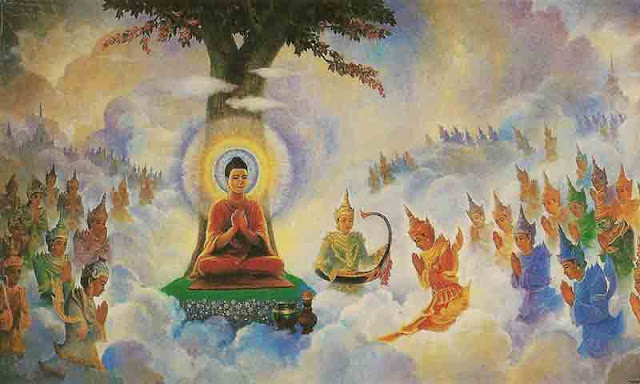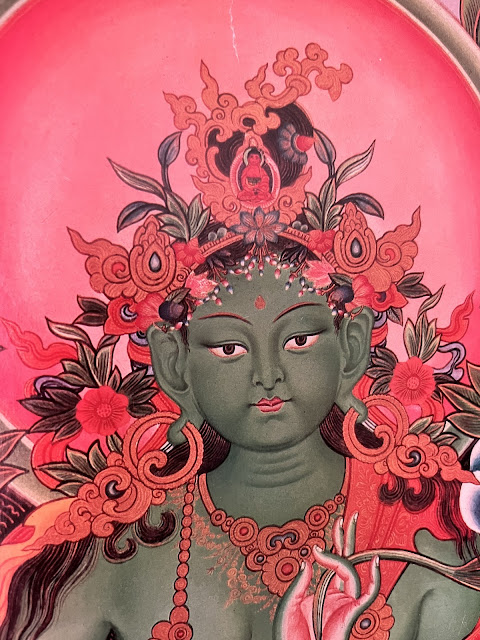I did not claim to have directly awakened to the right self-awakening unexcelled in the cosmos with its devas, Māras, & Brahmās, in this generation with its contemplatives & brahmans, its royalty & common people. But as soon as this—my eight-round heightened deva-knowledge-&-vision—was truly pure, then I did claim to have directly awakened to the right self-awakening unexcelled in the cosmos with its devas, Māras, & Brahmās, in this generation with its contemplatives & brahmans, its royalty & common people. Knowledge & vision arose in me: ‘Unprovoked is my release. This is the last birth. There is now no further-becoming.’” — AN 8:71
Friday, September 30, 2022
Wednesday, September 28, 2022
Adventures in Tara
Tuesday, September 27, 2022
Numbered Discourses quote
… “the Tathāgata is not concerned with whether the entire world will be emancipated by his teaching or half of it or a third part. But the Tathāgata is aware that whosoever has been emancipated, is now emancipated or will be emancipated from the world, all these will do so by removing the five hindrances that defile the mind and weaken understanding, by firmly establishing their minds in the four foundations of mindfulness, and by cultivating the seven factors of enlightenment in their true nature.”
Monday, September 26, 2022
Wednesday, September 21, 2022
Tara
When I was in the ordination process for Triratna I thought maybe I'd do a Avalokiteshvara sadhana. Then I destroyed things, sabotaged, lost contact with my preceptor. It's like calculus, I feel like I've taken so many algebra classes, in preparation to get to calculus, but I never got over that hump. I read Cultivating a Compassionate Heart by Thubten Chodron, but I didn't really feel like I knew enough to practice it, but I found an interesting book by Rachael Wooten, so I'm reading about Green Tara. My library has a copy and I've read some of it already and it seems like a good book.
I got a Green Tara poster once for Anandi, and she left it on my wall when she left. Left hand in the refuge mudra, ring finger to thumb.
I want to try it out. Anything that gives me energy to practice is a good thing. I know it's good not to flit from practice to practice without really devoting yourself, but I think it's OK to follow your interests also. Wooten was taught by Lodrö Tulku Lobsang Champa Khedup Namgyal Rinpoche, who seems to have been taught by many in the Gelugpa tradition.
I'm hesitant because usually it's part of a connection to a teacher that you do such things. And I wish I had somehow the ability to do the right dance to get one. I'm sure I will learn to when the time is right. I went along to a few zoom sessions with Sayka, and even witnessed an empowerment but they wanted me to come a bit more before they explained it. That kind of quid pro quo rubbed me the wrong way and I couldn't come all the time. I accept it that teachers can have a protocol for teaching, and I might not fulfill the requirements. In a way I want to be my own guru, not in narcissistic or solipsistic way, but self reliance in this period of my practice is somehow important. Anyway, I'm a dilettante, and it doesn't hurt to try something out and give up easily. Maybe it's a preliminary step to when I do get a teacher, and get sorted out. Who knows. I does become clear that doing this without a teacher is a mistake, a person to guide you seems essential. This is perhaps the weird truth of our age, you can get lots of teachings but without a teacher, it doesn't get the support it needs to really blossom.
I'm listening to the Black Tara mantra, because it dispels negativity. My daughter liked this one.
Link:
Green Tara mantra (Wildmind)
How to Do Green Tara Practice (Tricycle)
Take Refuge in Green Tara Tricycle
DECHEN / Black Tara Mantra (YouTube)
Black Tara Mantra (YouTube)
Black Tara Mantra (YouTube)
Intro to Green Tara Practice (Dawn Mountain YouTube. I think it's Anne C. Klein in Nyingma lineage)
Introduction to Green Tara and the 21 Taras (YouTube, White Conch)
True Face of the Buddha
So I got called a western convert perpetuating falsehoods for suggesting that the Buddha didn't want his image revered. (Source) "On this episode of "S@!#?@! Westerners Made Up About Buddhism":"
I read that this question is "sect-agnostic". A conflict between Theravada and Mahayana perhaps? ""The disciplines of austerity and contemplation Gautama had taught were now increasingly confined to a minority of orthodox .., the followers of Mahayana winning conversions among the masses. One sign of this was the proliferation in the first and second centuries AD of statues and representations of the Buddha, a practice hitherto restrained by the Buddha's prohibition of idol-worship." (Roberts 1995: 417) (ROBERTS; J.M. 1995. The Penguin History of the World. London: Penguin Group, 3rd edition.)
I like exploring things, see how I know things, learning deeper. I don't assume my present understanding is necessarily correct. My initial idea was that I remember some Pali Text where he folds a robe into a square and then puts a bowl on top of it to say how he wants to be remembered. That is the basis for a stupa. I can't seem to find it, if someone could put the references in the comments I would be eternally grateful.
Not all sources are equal and we have to use discernment while searching the internet. I'm not sure I have done that below, I just try to evaluating things I come across.
I also think he felt like he discovered an ancient city, and adopted the name Buddha for the state he attained. It's not called Siddhartha Gotamaism. It's depersonalized. It's not about his biography, it's about the path towards enlightenment.
So lets review the evidence. First you get a New York Times article that claims, “FOR THE FIRST six centuries after his death, the Buddha was never depicted in human form.” It is quite possible that this is inaccurate. Susan and John Huntington think perhaps images began to appear within a generation of his death. (Source)
Then, "The Buddha never suggested that he was above other men and did not want himself to become a deity to be worshiped." I don't know how accurate this website is.
"The sight of my foul body is useless; he who sees the Dhamma, he it is that seeth me" is a translation of "yo kho dhammam passati so mam passati; yo mam passati so dhammam passati" (source)
Also I've been taken by people who claim a certain image of the Buddha is the real image of his face. Here is one example:
I felt a conflict, because if someone believed the image was the real one and looking at that image really juiced up someone's practice, it seemed like almost a devotional act that didn't need to be true or false.
There's also the phenomenon whereby people make statues of the Buddha that look like a certain race, like if the Buddha was Thai or English. Similar things go on with Jesus.
Then there is the destruction of Buddha images by Muslims and Chinese Communists. This article claims the Buddha was a guide, not an icon. In government dissembling, Afghanistan representative claimed, "the images are being destroyed because there are no followers of Buddhism in Afghanistan to worship them".
""There is a misunderstanding that Buddhists try to worship idols," said Guoyuan Fashi, abbot at the Chan Meditation Center in New York City. "The main thing is that we respect the Buddha because we understand his teachings.""
It's from an art history standpoint that they are irreplaceable. Guo Yuan is talking about how to avoid anger, and says that you don't have to get angry at incorrect actions by others. I'm still fighting that teaching, because I think too much pacifism isn't good in a democracy, where people need to advocate and be heard. Chinese Chan was almost snuffed out by the Cultural Revolution. I get angry over the Cultural Revolution, the dynamiting of the Bamiyan statues in 2001 (source), and the sack of Nalanda by Bakhtiyar Khalji. It's part of Buddhist culture to say, "let it go," but I find religious persecution of any kind deplorable, and when it happens to my tradition, I feel extra outrage. I guess I'm not enlightened yet.
Monday, September 12, 2022
Job
Wednesday, September 07, 2022
Happy cake day Trancendentalism
Sangharakshita didn’t really like American Transcendentalist writing, and I can’t blame him. The movement that was born on this date, the first literary movement born on American soil was to counter the strict religious Puritans with a reliance on nature. A Buddhist doesn’t really care about the commitments of Puritans. The Americans were also trying to out Brahmin the American Brahmins, thus the tortured style. Emily Dickinson and Walt Whitman were the fruit of the movement, poets who just want to express their inner experience in this young nation.
Yes, over 500 tribes of Native Americans had a vibrant culture before, not literary, and I want to learn more about that. But there sacred images are guarded, and they are rightly reluctant to share their culture. Little spurts and blurts of culture come out. I love the below book, which I treat with reverence.
The Posture of Meditation by Will Johnson
Some quotes
“The Buddha enumerated approximately forty different techniques, and the Vigyana Bhairava Tantra (which Paul Reps translated in Zen Flesh, Zen Bones) lists one hundred eight different forms of practice, any of which is capable of taking the practitioner to the highest stages of realization.”
“the act of sitting itself may become even more important than the technique we are supposedly practicing while sitting.”
Thoughts on the text: This book came out in 1996. There are so many aspects to practice. There's figuring out the path, and what elements work for you to progress. There's figuring out how to relate to sangha and what sangha or sanghas do you want to work with. How many pujas can you get ahold of? Stripping it down to the studs, you enter the body. And inside the body, outside the body in mediation, there is posture.
In the age of information, I think it's hard to read through a whole book, even a small one like this.
Thursday, September 01, 2022
Buddha
“Having been one I became many; having been many I became one. I appeared. I vanished. I went unimpeded through walls, ramparts, & mountains as if through space. I dove in and out of the earth as if it were water. I walked on water without sinking as if it were dry land. Sitting cross-legged I flew through the air like a winged bird. With my hand I touched and stroked even the sun & moon, so mighty & powerful. I exercised influence with my body even as far as the Brahmā worlds. I could witness this for myself whenever there was an opening.”
AN 5:68















